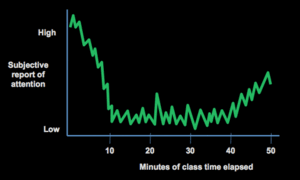By Dr. Ken Broda Bahm:
The jurors lean forward in their seats a bit as they have their first chance to hear about the case in opening statement. The attorney steps to the lectern, looks directly at the panel, pauses, raises his hand for emphasis and…reintroduces himself and everyone sitting at counsel table. “You’ve already met me, my name is…and I represent….” Then, once the introductions are out of the way, he proceeds straight into the remarks he always uses to congratulate the jurors and say, “Thank you for your service,” and also share a few quotations: “Jurors are really important for a democracy.” With that step accomplished, it is time to hear about what an opening statement is and isn’t: “It isn’t evidence, it is the picture on the top of the puzzle box,” and so on. At this point, nearly ten minutes into the attorney’s time, the jury has noticeably changed. No longer on the edges of their seats, they’ve become accustomed to the realization that an opening statement is neither as exciting or concise as it’s Law & Order versions. They’re drifting off and thinking of other things, just as the lawyer is finally coming round to talking about the case.
That is an opportunity lost. At a time when the jury’s attention is at its peak, the attorney focused on formalities and platitudes. Instead of using those few golden moments of fresh attention to aggresively convey a trial theme and frame the case story from his perspective, he simply followed a routine. “But,” he will counter, “I did get into the theme and the story right after that.” And it is true that any powerful appeal he could have put into the first few minutes he can always add later. But attention will never again be as high as it was during those initial moments when the attorney and the presentation were both new and juror focus was on overdrive. Make a strong statement in your introduction — not ten minutes in, and not even two minutes in. Make it right at the start. It is common advice and I make it frequently. But I still see it violated even more frequently. This post takes a look at why those initial minutes are so important and provides a quick list of what should be banned and what should be stressed during that precious span.
The Attention Curve:
 The general understanding is that attention toward a speaker is at its peak at the beginning, and then declines swiftly and steadily throughout the presentation before dipping up a bit at the end. As this representative graph shows, the first part of it looks a lot like the stock market in 2008. The reason for this steep attention curve is that at the beginning, the speaker, the speech, and the situation all have novelty on their side, and that generates attention. But once the style, the person, and the topic become familiar, then it becomes harder to sustain that attention. It is true that a good speaker can recapture attention, creating smaller peaks along the way, but it remains unlikely that attention will ever get back to that original point, even with serious efforts from the speaker to keep or recapture attention. The main lesson regarding early attention: make the most of it while you still have it.
The general understanding is that attention toward a speaker is at its peak at the beginning, and then declines swiftly and steadily throughout the presentation before dipping up a bit at the end. As this representative graph shows, the first part of it looks a lot like the stock market in 2008. The reason for this steep attention curve is that at the beginning, the speaker, the speech, and the situation all have novelty on their side, and that generates attention. But once the style, the person, and the topic become familiar, then it becomes harder to sustain that attention. It is true that a good speaker can recapture attention, creating smaller peaks along the way, but it remains unlikely that attention will ever get back to that original point, even with serious efforts from the speaker to keep or recapture attention. The main lesson regarding early attention: make the most of it while you still have it.
These Should Be Banned From the First Few Minutes of Opening:
Reintroducing Yourself and Your Team. To the extent that jurors need this, and don’t already know who everyone is from voir dire, you can return to the topic after you have established your theme and set a tone in the first few minutes.
Repeating the Judge’s Instructions. If the sentence begins with “As you just heard from the judge…” then the sentence is probably not necessary.
Playing Down the Importance of Opening Statement. Emphasizing that “What we say here is not evidence” and “soon, you’ll be hearing from the important witnesses,” can end up conveying the message, “So it is totally okay if you don’t pay attention for the next hour or so.”
Quoting Thomas Jefferson, Alexis de Toqueville, or Harper Lee on the Importance of Juries. Yes, there are some moving quotations out there, and they speak to the truth of the sanctity of jury service. But when delivered at the start, they can sound, somewhat accurately, like ingratiation. There are better times, like closing, where you will want to empower the jurors by reminding them of the importance of their role.
Anything Else That Does Not Immediately Get to the Point of Your Case. While you have the greatest access to the eyes, ears, and cognitive resources of the jury, hit them with your best shot.
Instead, Do This
Get to Your Theme. Your one sentence or so that boils your case down in a powerful way should make an appearance as early as possible and come back often in the opening statement.
Identify. Connect with where jurors are likely to be at that point. Play the ball where it lies by acknowledging what they might be thinking, for example, after hearing the other side.
Surprise. Give jurors something they don’t expect, something that flies in the face of what they are assuming that you and your party will say in this situation.
Acknowledge. If there is an obvious weakness, or a elephant in the room that everyone is likely to see, then go ahead and ‘steer into the skid’ by acknowledging that weakness.
Start a Story. If you see someone throw a ball, you can’t help but watch until you see whether the ball is caught or not. A narrative arc inherently grabs attention.
Create a Frame. The context and framework that is placed around your case will play an important role in determining how your story is evaluated, so begin creating that frame.
Analogize. Teach the new in terms of the known. Analogies and metaphors make use of a familiar situation to encourage jurors to think in a particular way about your case.
Bottom line, when you’re starting out, don’t rely on what is habitual, routine, or rote. Instead, push yourself to create the opposite, and get to that right away.
______
Other Posts on Opening Statement:
- Your Opening: Tell It Like a Story, but Tailor It Like a Strategy
- Take a Lesson from the Conrad Murray Defense: Don’t Make Promises in Opening that You Can’t Keep
- Overlap Your Stories
______
Photo Credit for Header Image: 123rf.com, used under license.
Image Credit for attention curve chart: Hartley J and Davies I “Note taking: A critical review” Programmed Learning and Educational technology, 1978,15, 207-224 cited in Brain Rules (Medina, 2009).
